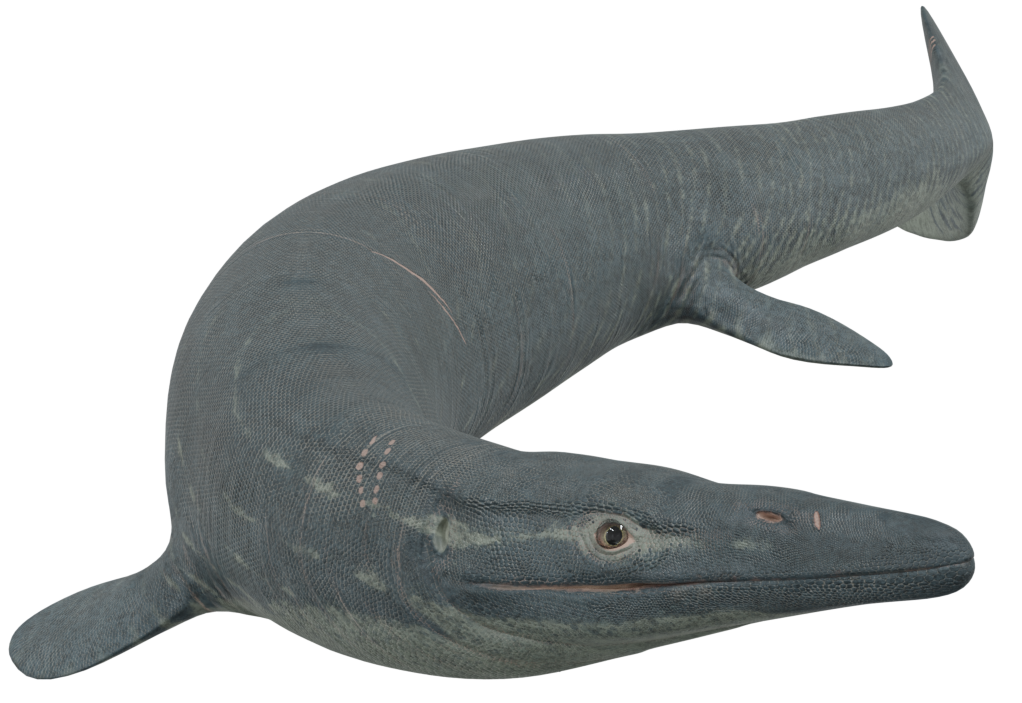Little Mosasaur, Big Sea
When we think of mosasaurs, we usually think of giant forms such as Mosasurus, but Eonatator, a mini mosasaur discovered in Kansas, shows that in a vast sea full of ferocious leviathans, there was still room for the little guys.
Overview: As dinosaurs continued their rule of the land during the Late Cretaceous, rulership of the sea belonged to the mosasaurs, with a variety of sharks and other killer fish also sharing in the predatory niches. When we think of mosasaurs, we usually think of the giant forms such as Mosasurus, Tylosaurus, or Prognathodon, some of which would probably send the largest of today's ocean predators swimming for their lives. But Eonatator, a small mosasaur discovered in the chalk deposits of Kansas in the early 20th century by the great Charles Sternberg and named in the early 21st Century, shows that in a sea full of ferocious leviathans, there was still room for the little guys.
Discovery: The holotype of Eonatator was discovered in the Smoky Hill Chalk Member of the Niobrara Chalk Formation of Kansas. It was found by the great Charles Sternberg (legendary paleontologist who excavated and studied the animals of the Western Interior Seaway in the early 20th Century) and his son in 1918, and in 1920 it was named a new species of the mosasaur genus Clidastes by Swedish paleontologist Carl Wiman. Later, it was reclassified as a species of Halisaurus, though this was not accepted by all. In 2005, it was given its own genus, Eonatator, by Nathalie Bardet and colleagues. Eonatator is Greek and Latin meaning “dawn swimmer”, derived from Greek “eos”, meaning dawn and Latin natator, meaning swimmer. The species name, given by Wiman in 1920, honors Charles and Levi Sternberg who found the specimen. Additional specimens have been discovered in the Eutaw and Mooreville Chalk Formations of Alabama, and fittingly, remains have also been found in the Kristianstad Basin of Sweden, the home country of Carl Wiman who first named the species. A second species of Eonatator, E. coellensis was discovered near Coello, Columbia, and named in 2013.
Evolution: Eonatator was a mosasaur in the family Mosasauridae, and the subfamily Halisaurinae. Mosasaurs were sea-going lizards. Early members of Mosasauria, such as the Agialosauridae, were more lizard-like and retained feet (plesiopedal condition) and probably would have had a semi-marine lifestyle, similar to some crocodiles or water monitor lizards and would have been restricted to shallow coastal waters. The more derived family Mosasauridae were entirely marine and were the dominant group of marine predators in the Late Cretaceous. Mosasaurs are thought to be relatives, monitor lizards, snakes or both, and much debate has been had over which, if either, they are closer related to, as they share features with both groups. Monitor lizards and snakes may themselves be somewhat close relatives in the clade Toxicofera, so regardless of which group mosasaurs are closest to, they may indeed be relatives of both. Within the Mosasauridae, Eonatator is a member of the subfamily Halisaurinae, which have more basal mosasaur characteristics, most notably poorly differentiated flippers, which would make them less-adept swimmers. It has been suggested that Halisaurines are the most primitive of all mosasaurs, but more recently they have been found to be a sister group to the mosasaurines, which would mean halisaurines aren’t necessarily more basal, but do retain more primitive traits (plesiomorphic). Additionally, halisaurines tended to be smaller than most other mosasaurs, though mosasaurs were a diverse group there was considerable size overlap between the different clades and high variability within clades.
Physical Description and Ecology: At only 2.6 meters (8.5 ft) long, and weighing about 45 kg (99 lbs), Eonatator sternbegii was small for a Mosasaur, though it was not the smallest (that title belongs to Dallasaurus which was only 1 m in length and weighed only 2 kg). Eonatator was a typical mosasaur in that it had a moderately elongated body and tail, a long snout, flippers instead of feet, and a tail fluke which helped it swim. Mosasaurs were so adapted to marine life that they probably gave birth to live young instead of laying eggs. Like other mosasaurs, it was a marine predator, equipped with conical teeth for holding onto slippery prey, and a second row of palatal teeth at the back of the roof of its mouth for extra prey gripping power. The prey size of Eonatator was undoubtedly smaller than some of the other mosasaurs with which it shared its environment. In fact, Eonatator was itself likely food for many of these bigger sea monsters. Other Mosasaurs present in the Western Interior Seaway (the sea that connected the Gulf of Mexico to Hudson Bay and the Arctic Ocean during the Late Cretaceous) included slightly larger Clidastes, the shell-crushing Globidens, and the much larger macropredatory Prognathodon, Tylosaurus, and Mosasaurus. These latter three would have likely been predators of Eonatator. Besides these, other sea monsters would have been potential competitors and/or predators of Eonatator, including the medium-sized shark Cretalamna (a probable ancestor of the much later and much larger Megalodon), the very large (26 ft) shark Cretoxyrhina, and the fearsome 5–6 meter (16.4–19.7 ft) “Bulldog Fish” Xiphactinus.
Extinction and Legacy: Eonatator sternbergii lived during the Santonian and early Campanian Ages of the Late Cretaceous. It may have disappeared due to competition from other mosasaurs, or possibly due to the receding of the Western Interior Seaway which began at the end of the Campanian. However, its halisaurine relatives continued on until the end of the Cretaceous when they, along with all of the non-avian dinosaurs and 75% of all life on earth were wiped out by an asteroid impact in the Gulf of Mexico. The holotype of Eonatator sternbergii is housed in the Uppsala University Palaeontological Institute, in Uppsala, Sweden.
Eonatator FAQ
Eonatator size / How big was an Eonatator?
See weight and length.
Eonatator weight / How much did an Eonatator weigh?
Eonatator sternbergii probably weighed around 50 kg (~110 lbs), similar to a large Asian water monitor lizard.
How long was Eonatator?
Eonatator sternbergii was about 2.6 meters (8.5 ft) long.
What did Eonatator eat?
Eonatator ate other marine animals, perhaps mostly fish, but also possibly other marine reptiles and ammonites.
What is Eonatator’s closest living relative?
The closest living relative to mosasaurs like Eonatator are snakes and monitor lizards, like the Komodo dragon.
Eonatator family members / Eonatator family / What kind of animal was Eonatator?
Eonatator was a mosasaur, a clade of carnivorous marine lizards. It was member of the family Mosasauridae, making it a relative of larger and more famous mosasaurs such as Mosasaurus, Tylosaurus, and Prognathodon.
Where did Eonatator live? / Where was Eonatator found?
Eonatator lived in shallow seas that once covered central North America and Europe, with fossils having been found in Kansas, Alabama, and Sweden.
When did Eonatator live?
Eonatator lived about 84-72 million years ago during the Late Cretaceous Period.
What does Eonatator mean? / Eonatator name meaning
Eonatator means “dawn swimmer”.

